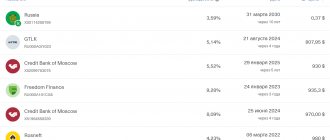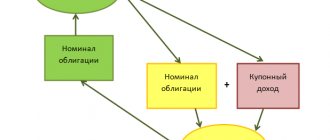What are Federal Loan Bonds and which OFZs are best to buy now. Bond prices, government bond investments, maturities and yields.
If you buy federal loan bonds (OFZ), you can achieve a yield that exceeds the bank one, without compromising reliability. Federal loan bonds are a popular instrument among investors.
The popularity of this type of debt securities is evidenced by statistics from the Moscow Exchange. According to the exchange, trading volume on bonds of all types exceeded 2.8 trillion rubles
. The monthly OFZ trading volume amounts to hundreds of billions of rubles.
What are OFZs and why are they needed?
OFZs are securities issued by the Ministry of Finance. The government of the Russian Federation pays interest on these securities, and also returns the face value of the government bond upon redemption. The purchase of such securities provides interest income on a regular basis - as a rule, payments are received every six months.
Tip: Don't want to understand the intricacies of bonds? Then the smart decision may be to purchase national OFZs. Government bonds for the population (OFZ-n) are securities issued by the Ministry of Finance for distribution among ordinary citizens. Such papers allow the population to lend money to the state and quickly receive income. Bonds of individuals can be purchased exclusively from large banks - Sberbank, VTB, etc.
The principle of operation of government bonds (bonds) is extremely simple: the Ministry of Finance of the Russian Federation issues and submits them for trading, then they are purchased by investors for further sale on the stock exchange, where government bonds are traded as a percentage of their face value - for example, at 95%, the price of OFZ will be 950 rubles. The cost of bonds directly depends on supply and demand.
For the use of funds, the Ministry of Finance pays certain interest - coupons. As a rule, payments occur twice a year, every one hundred and eighty-two days. For example, users of the VTB My Investments application have access to a special bond calendar indicating the value of coupons and the regularity of payments. The investor who owns the government bond receives income - and if you sell the security before the Ministry of Finance pays the next coupon, you will still be able to receive the funds (they will be paid by the purchaser of your government bond).
Calculation of purchases using an example
For example, I’ll take OFZ 26224, issued in February 2022. Its nominal value is 1000 rubles, the annual coupon rate is 6.90%. This is a government paper with a constant income, so the coupon will be relevant not only for 2022, but also for all subsequent periods. Coupon payment 2 times a year. The instrument is scheduled to mature in 2029; its market value is now 92.5% of its face value.
Those. any individual who opens an account with a broker will be able to buy this promissory note for 925 rubles. By opening the online calculation calculator, the investor will see that he will receive a current yield to maturity of around 8.16% per annum.
Now an example for individuals. Sberbank is now offering OFZ-N of the third issue No. 53003. These federal loan notes have been issued since September 17, 2022. The coupon is paid every 182 days. The purchase price is set at 100% of the face value, or 1000 rubles. The coupon rate is 7.25% per annum.
Types of bonds
Depending on the repayment period, government bonds can be short-term (up to a year), medium-term (from one to five years) and long-term (from five to thirty years). Unlike other countries, the Russian Ministry of Finance has not yet issued bonds with a maturity of more than thirty years. The nomenclature of government bonds implies the indication of two alphanumeric designations containing comprehensive information about the bond - ISIN and state registration number.
Classification by type of coupon payments
Based on the type of coupon payments, OFZs are divided into 4 groups:
- government bonds with constant payments that do not change throughout the life of the bond;
- government bonds with variable payments - their interest depends on inflation in a specific period of time;
- zero-coupon OFZs - in this case, interest payments will not be made, however, the cost of placing OFZs among investors may be 20% lower than the nominal value;
- government bonds with an indexed coupon - for example, the coupon can be indexed depending on the amount of inflation or the cost of oil.
Systematization by face value
Securities are purchased on the stock exchange, their volume is measured in lots - that is, one lot is equal to one bond. The face value of most government bonds is 1000 rubles. For public bonds, a minimum purchase volume of 30,000 rubles is provided. Along with the market price and coupon rate, the par value is one of the main parameters for calculating profitability.
Advice: It is important to note that profitability directly depends on the Central Bank rate. At the same time, bonds with an indexed par value imply an annual increase in par value by the amount of inflation, and amortizing bonds require repayment in installments and a gradual decrease in par value.
Are there any risks?
It is rare, but it still happens that the borrower cannot fulfill its obligations - for example, the region delays payments on coupons. A technical default may be declared: when the borrower has the opportunity to pay funds to investors, but for some reason he is overdue. All information about defaults can be tracked on the websites of the Moscow or St. Petersburg Stock Exchange.
Remember about amortization, which is when you gradually get back some of the money you invested in bonds. In addition to the fact that you can get back part of the funds and, for example, invest them in new bonds, this instrument also speaks about the solvency of the region to which you lent. On the other hand, after part of the loan is repaid, coupons will be awarded for the remaining part, and not for the full amount of the loan. That is, if you bought 10 bonds for 1000 rubles each, with each depreciation, for example, 250 rubles, you will receive coupons only for the balance.
FSBU REVIEW 6/2020, 26/2020
What specific actions should an accountant take to make the transition to the new Federal Accounting Standards correctly and in a timely manner? What entries should be made in accounting?
Only on January 31 (Monday) a step-by-step analysis of the transition to new standards in a three-hour webinar with Sergei Vereshchagin.
Sign up>>>
Advantages and disadvantages
Like any other financial instrument, OFZs have their own advantages and disadvantages.
Key advantages of government bonds:
- Low minimum investment amount - the nominal value of a government bond is 1,000 rubles, so any citizen can buy debt securities.
- Various repayment periods and ease of sale - OFZs are considered quite liquid; trading turnover in 1 day can reach more than 1,000,000 rubles.
- Wide range - there are currently 41 OFZs on the exchange, so you can choose the option that best suits you in terms of profitability, cost and repayment period (you can buy securities in your personal account of Sberbank and VTB24).
- A worthy alternative to bank deposits - unlike bank deposits, government bonds provide a return of the entire investment amount without any restrictions.
- The highest reliability - securities are issued and regulated by the state, and an increase in income occurs during the period of ownership of the government bond.
- Preferential taxation - there is no tax collection on income from coupon payments for individuals.
Advice: Don’t want to predict changes in the key rate? Then it is better to choose short bonds - since their value does not change as significantly as that of long issues. A federal loan with a maturity of up to three years will be considered short, and from three years - long. Coupons can be constant or variable, so before choosing government bonds, you should correctly determine the yield - this parameter depends on the size of the coupon, the difference between the purchase and sale prices of OFZ.
The imperfections of OFZs can be detected if you compare them with other securities on the stock exchange.
The main disadvantages of government bonds:
- Low yield - compared to corporate bonds, OFZs have a lower yield, but the risks of non-payment are also lower.
- Possible sanctions - the introduction of a ban on OFZ trading for foreign citizens may adversely affect the price of these securities.
Our main conclusion
Since the beginning of the year, the yield on ruble government bonds has reached multi-month highs, reaching the levels of April 2022, when the most stringent restrictive measures were in force in Russia.
The market is under pressure both due to external factors (including the risk of new sanctions and rising yields on US government securities) and due to a review of the Russian Central Bank's strategy in the field of monetary stimulation. The current yield of ten-year OFZs (series 26228) has already exceeded 6.6% per annum, having increased by more than 65 bp since the beginning of January. According to our assessment, at these levels sovereign securities become attractive, including in comparison with peers in other emerging markets. For example, the spread between 10-year government bonds of Russia and Mexico is now at an annual maximum (which partly reflects the different directions of monetary policy (MP) of the central banks of the two countries). We estimate that the fair yield level for the 10-year benchmark should be no higher than 6%, which corresponds to a price increase of at least 5% from current levels. Our forecast for the key rate at the end of 2022 and 2022. is 4.25% and 5% respectively.
Thus, we expect a gradual return of demand for “classic” OFZs in the near future, provided that potential sanctions will be limited (affect only individual individuals and legal entities) and recommend starting to build up positions in securities with maturities over 10 years.
Dynamics of 10-year government bond yields in national currency, %
Source: Bloomberg, ITI Capital
How to choose OFZ for investment
When choosing debt securities, you should take into account the period remaining until maturity, as well as the type and value of the government bond. Proper selection of OFZ allows you to receive constant payments of the coupon rate or interest. Government bonds are often subject to sale. In addition, the income received can be invested in the purchase of new government bonds or shares of highly reliable issuers.
How is the OFZ rate calculated?
The nominal rate of government bonds is expressed as a percentage per annum. The term “effective rate” implies taking into account the fact that the interest that was obtained on income for the first year will be reinvested in the second. The interest rate on government bonds can be fixed or variable. The coupon rate is determined by the circulation period of the OFZ.
What are the returns and risks?
The yield of government bonds is determined by the time of issue and circulation period - now this value ranges from 7.5 to 10.5%. Purchasing government bonds does not relieve the investor from certain risks (such risks include issuer default and ruble depreciation). If the Central Bank of the Russian Federation suddenly raises the rate (as it did in 2014), then the value of bonds traded on the market will fall, and profitability will accordingly increase.
Are they taxable?
If you decide to try to make money on OFZs, you should remember that this earnings will be supplemented by tax deductions (13% personal income tax), which are provided only if the investor has not sold government bonds for three years. The minimum investment amount in this case should be 400,000 rubles per individual investment account, and the tax deduction amount should be 52,000 rubles for three years. Investors who decide to sell government bonds before the end of three years of investment are required to pay tax (9%).
Is it worth investing: benefits from the purchase
Most entrepreneurs prefer to invest financial resources in Russian securities - this method allows them to obtain a guaranteed financial flow of profit. The benefits of OFZs were appreciated by foreign investors - the buyers of approximately 40% of government bonds are non-residents.
Is it possible to buy on IIS?
Almost all bonds (except Eurobonds) can be purchased through an open individual investment account.
Where can I see the list of products available for purchase?
The list of available government bonds is presented on such resources as:
- www.moex.com (MOEX exchange website);
- www.quote.rbc.ru (RBC agency website);
- www.smart-lab.ru/q/ofz/ and other sites dedicated to investments.
How much does 1 piece cost?
The price of one OFZ is approximately 1030 ₽. The price of securities on the market depends on demand, supply and market conditions.
Investor reviews
- Private pension fund "Radost". Our investors trust us with their money largely because we invest their money only in highly reliable assets. Bonds in our portfolio make up at least 90%.
Drawing. Comparison of bank deposit and OFZ in terms of profitability.
- Vasily Ivanovich is a private investor. I invest money only in OFZs, since there is no longer any trust in deposits in the banking system, much less in the Russian stock market, not to mention all sorts of forex and binary options.
Drawing. Investment preferences of Russians.
- Vasilisa. I withdrew all the money from my bank account and used it to buy “folk” OFZs through IIS - the interest rate is higher and it will be more secure.
Drawing. Dynamics of investment activity of Russian citizens in the IIS and OFZ market.
Where are traded and who can buy OFZ
People's government bonds have become widespread among private investors (through agent banks such as Rosselkhozbank, etc.), and other OFZs are traded on the Moscow Exchange (MOEX). OFZs are characterized by low volatility - in this case there are no jerks of 5-10 percent during one trading session.
Is it possible to buy OFZ without intermediaries?
Ordinary government bonds can be purchased directly - if the seller is a private or legal entity. The transfer of ownership of government bonds is regulated by the Civil Code of the Russian Federation and is carried out under a purchase and sale agreement, which must be notarized and registered with Rosreestr.
Best brokers
Many people prefer to purchase securities through brokers - in this case, one or another brokerage organization will be able to fulfill the obligations of a tax agent. The most popular brokers include companies such as Otkritie, Promsvyaz, Ricom, BCS, Keith, Finam and Tinkoff.
Bottom line: pros and cons
To summarize, we note that federal loan bonds are considered an acceptable option for placing financial resources with a low level of risk. Of course, you will not receive excess income, but you will be able to receive more than on your deposit (provided you choose a bond with the optimal interest rate).
The main disadvantage of government bonds is the threat of depreciation of income due to inflation. Also, the disadvantages of OFZs include possible restrictions from foreign authorities - non-residents in this case will begin to quickly get rid of OFZs, and this will negatively affect their price. The undeniable advantages of using government bonds are the stability of payments over a long period of time and the almost absolute absence of the risk of bankruptcy - as we know, there are no prerequisites for defaults to occur at the moment.











